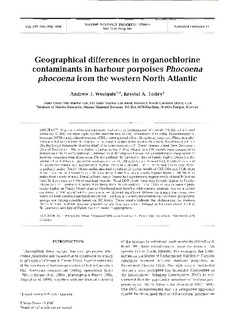| dc.description.abstract | Organochlorine contaminants, including polychlorinated biphenyls (PCBs), chlorinated bornanes (CHBs), dichloro-diphenyl-trichloro ethanes (DDTs), chlordanes (CHLORs), hexachlorocyclohexanes (HCHs) and, chlorobenzenes (CBZs) were quantified in 188 harbour porpoises (Phocoena phocoena) killed in commercial fisheries in the coastal waters of the Avalon Peninsula, Newfoundland (n = 29), the Gaspe Peninsula, Quebec (Gulf of St. Lawrence) (n = 58), Grand Manan Island, New Brunswick (Bay of Fundy) (n = 86), and Jeffreys Ledge in the Gulf of Maine (n = 15). Levels were compared to determine if there were systematic differences in the organochlorine (OC) contaminant composition of harbour porpoises from these areas (Newfoundland, St. Lawrence, Bay of Fundy-Gulf of Maine) in the western North Atlantic. Bivariate analyses run on all 188 individuals showed both Fundy-Maine and St. Lawrence males had significantly higher levels of CHLORs, DDTs, PCBs and CHBs than Newfoundland males. Fundy-Maine males also had significantly higher levels of CHLORs and PCBs than those from the St. Lawrence and St. Lawrence males had significantly higher levels of HCHs than males from Fundy-Maine. Females from Fundy-Maine had significantly higher levels of total PCB than both St. Lawrence and Newfoundland females. Total DDT levels were significantly higher in Fundy-Maine and St. Lawrence females than those from Newfoundland. Total CHLOR values were significantly higher in Fundy-Maine than in Newfoundland females. Multivariate analysis, run on a subset consisting of 100 immature harbour porpoises showed significant differences among the group centroids on both discriminant functions (Wilks' Lambda; p < 0.001) demonstrating that these geographic groups are distinguishable based on OC levels. These results indicate that delineating the western North Atlantic harbour porpoise population into sub-populations defined as Newfoundland, Gulf of St. Lawrence and Bay of Fundy-Gulf of Maine is appropriate. | en |
